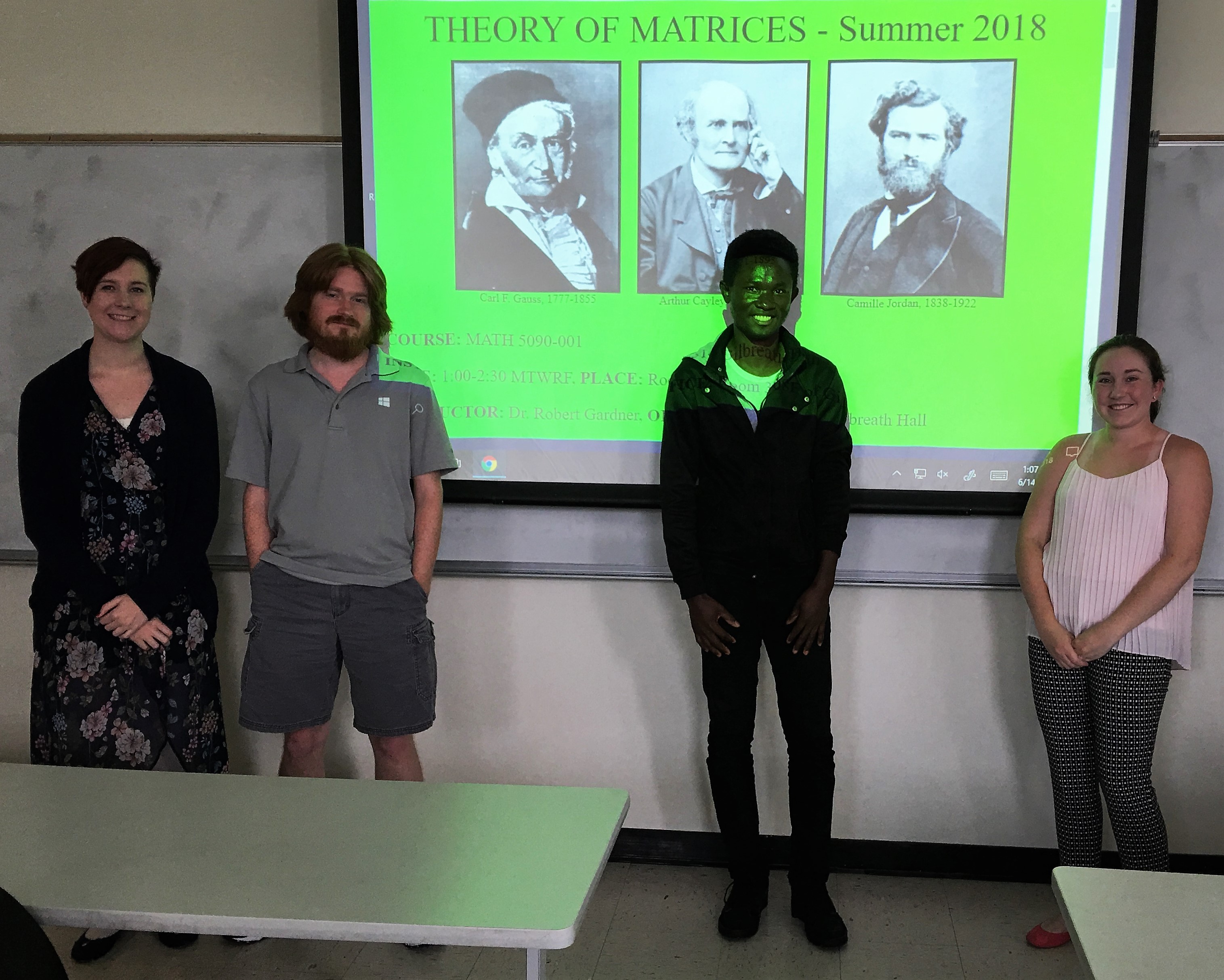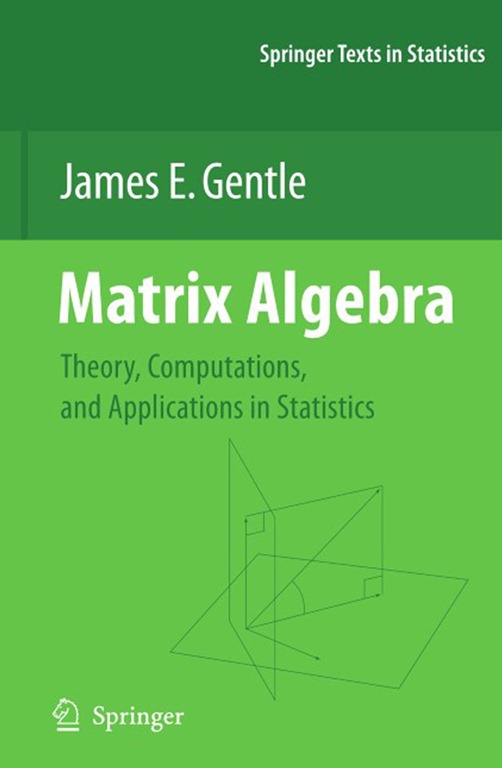 Carl F. Gauss, 1777-1855 |
 Arthur Cayley, 1821-1895 |
 Camille Jordan, 1838-1922 |
 Carl F. Gauss, 1777-1855 |
 Arthur Cayley, 1821-1895 |
 Camille Jordan, 1838-1922 |

COURSE: MATH 5090-001
TIME: 1:00-2:30 MTWRF, PLACE: Room 314 Gilbreath Hall
INSTRUCTOR: Dr. Robert Gardner, OFFICE: Room 308F of Gilbreath Hall
OFFICE HOURS: Available after 2:30 PHONE: 439-6979 (Math Office 439-4349)
E-MAIL: gardnerr@etsu.edu
WEBPAGE: http://faculty.etsu.edu/gardnerr/gardner.htm
TEXT: Matrix Algebra: Theory, Computations, and Applications in Statistics, by James E. Gentle, Springer (2007).

ABOUT THE COURSE: The catalog description of this class is very brief: "Vector spaces, linear transformations, matrices, and inner product spaces." In light of our department's name, "The Department of Mathematics and Statistics," this class will try to branch these two areas. This is why I have chosen a textbook in the "Springer Texts in Statistics" series. Our plan is to cover the first 5 chapters of the textbook, Matrix Algebra: Theory, Computations, and Applications in Statistics, which is the "Theory" part of the book. The author of the text states (see page viii) "...the presentation is informal; neither definitions nor facts are highlighted by words as 'Definition', 'Theorem', 'Lemma', and so forth. ... Most of the facts have simple proofs, and most proofs are given naturally in the text. No 'Proof' and 'Q.E.D.' or '■' appear to indicate beginning and end." I don't agree with this and will be introducing exactly the definition/theorem/proof approach in the class notes. I will number results contained in Gentle's book (such as "Theorem 3.2.1") and I will label results from other sources by the section and a letter (such as "Theorem 3.2.A"). I will not take as much of a theoretical approach as I do in my other graduate-level classes. For example, we will deal with matrices with real entries and not deal with the entries as elements of a field nor with the more abstract algebra properties of matrices.
ONLINE NOTES: Online notes in PDF form are available for each section we cover. The notes include definitions, some motivational comments, and statements of lemmas, theorems, and corollaries, but the notes themselves mostly omit the detailed proofs. Detailed proofs are given in supplemental files. The notes and supplement can be found at:
GRADING: Homework will be assigned on a regular basis and your grade on the homework will determine your grade for the course. Grades will be assigned based on a 10 point scale with "plus" and "minus" grades being assigned as appropriate. Based on the assignment of grade points by ETSU, the plus and minus grades should be given on a 3 point subscale. For example, a B+ corresponds to an average of 87, 88, or 89; an A- corresponds to an average of 90, 91, or 92; an A corresponds to an average of 93 to 100 (ETSU does not grant A+ grades, nor D- grades), etc.
A NOTE ABOUT HOMEWORK: YOU MUST SHOW ALL DETAILS ON THE HOMEWORK PROBLEMS!!! Justify every step and claim you make - this is how you convince me that you know what you are doing. You may find some answers online, but these rarely sufficiently justify all steps and are unacceptable as homework solutions.
ACADEMIC MISCONDUCT: While I suspect that you may work with each other on the homework problems (in fact, I encourage you to), I expect that the work you turn in is your own and that you understand it. Some of the homework problems are fairly standard for this class, and you may find proofs online or in an online version of the solutions manual. The online proofs may not be done with the notation, definitions, and specific methods which we are developing and, therefore, are not acceptable for this class. If I get homework from two (or more) of you that is virtually identical, then neither of you will get any credit. If you copy homework solutions from an online source, then you will get no credit. These are examples of plagiarism and I will have to act on this as spelled out on ETSU's "Academic Integrity @ ETSU" webpage: http://www.etsu.edu/academicintegrity/ (last accessed 6/3/2018). To avoid this, do not copy homework and turn it in as your own!!! Even if you collaborate with someone, if you write the homework problems out in such a way that you understand all of the little steps and details, then it will be unique and your own work. If your homework is identical to one of your classmates, with the exception of using different symbols/variables and changing "hence" to "therefore," then we have a problem! If you copy a solution from a solution manual or from a website, then we have a problem! I will not hesitate to charge you with academic misconduct under these conditions. When such a charge is lodged, the dean of the School of Graduate Studies is contacted. Repeated or flagrant academic misconduct violations can lead to suspension and/or expulsion from the university (the final decision is made by the School of Graduate studies and the graduate dean, Dr. McIntosh).
TENTATIVE OUTLINE:
We will attempt to cover topics from this list:
Chapter 1: Basic Vector/Matrix Structure and Notation.
Vectors, matrices, data.
Chapter 2: Vectors and Vector Spaces.
Linear combinations, linear independence, vector spaces, basis, innner products, norms, metrics, orthogonality, projections, orthonormal basis, cones, mean and centered vectors, standard deviation and variance vectors, covariances and correlations.
Chapter 3: Basic Properties of Matrices.
Multiplication, elementary operations, trace, outer products, rank, determinants, partitioned matrices, linear systems, inverses, othrogonality, eigenvalues/eigenvectors, spectrum, diagonalization, positive definite, singular values, matrix norms.
Chapter 4: Vector/Matrix Derivatives and Integrals.
Types of differentiation, optimization, integration, expectation, random variables.
Chapter 5: Matrix Transformations and Factorizations.
Geometric transformations, factorizations of matrices, LU an dLDU factorizations, QR factorization, square roots.
Chapter 6: Solutions of Linear Systems.
Direct methods, Gaussian Elimination, iterative methods, overdetermined systems, least squares, minimization in terms of other norms.
Chapter 7: Evaluation of Eigenvalues and Eigenvectors.
computationa methods, Jacobi method, QR method, single value decomposition.
TENTATIVE SCHEDULE: This is ambitious!
Week 1: Chapter 1, Chapter 2.
Week 2: Chapter 3.
Week 3: Chapter 3.
Week 4: Chapter 5.
Week 5: Chapter 4, topics from Chapters 6 and 7.
IMPORTANT DATES: Official dates are online at:
OTHER RESOURCES. The following were mentioned in class:
| |
||||
Return to
Bob Gardner's home page
Last updated: July 4, 2018.